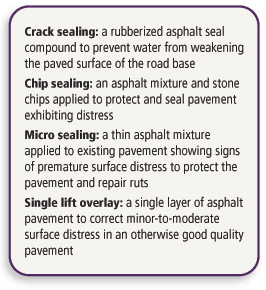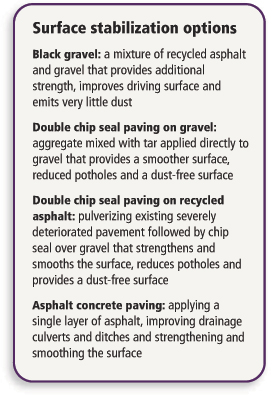
Making Our Dollars Go Further
To get the best value for our investment, we are taking a more balanced approach, a principle of the department's highway improvement planning.
While we continue to address the most severely damaged roads on a "worst first" basis, a larger portion of the highway improvement budget is being directed toward improving paved roads before they become severely damaged and need more costly repairs. Although we continue to face significant road improvement needs, this approach will ensure that funding is used in a more efficient and effective way.
This more balanced approach, using the latest treatment options and preservation techniques, will provide a number of benefits, including
- improving more roads in more communities
- providing a hard surface for more gravel roads
- paving smarter by preventing more costly problems before they happen
- improving more low-volume paved roads
 Pavement preservation
Pavement preservationPavement preservation involves extending the useful life of asphalt to improve smoothness, reduce potholes, and decrease rutting and cracking. This keeps the roads smoother and safer at a much lower cost than allowing them to deteriorate to the point of needing full reconstruction. There are various methods of pavement preservation, including(see right)
Surface stabilization
Local, low-volume roads
 Surface stabilization involves using a variety of
treatments to improve local road conditions,
resulting in smoother, dust-free road surfaces for
drivers. Options include(see right)
Surface stabilization involves using a variety of
treatments to improve local road conditions,
resulting in smoother, dust-free road surfaces for
drivers. Options include(see right)
Mobile Asphalt Plant
Government has committed to increase resurfacing of secondary (non-100 series) roads by 50 per cent. To help achieve that goal the Department of Transportation and Infrastructure Renewal will set up a mobile asphalt plant this summer within the existing budget. There will be savings for taxpayers, as this publiclyowned venture will ensure competitive prices and allow the province to pave more roads in all areas.